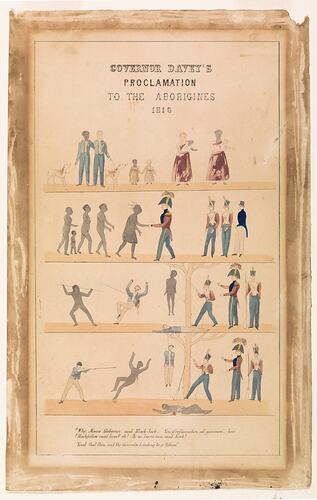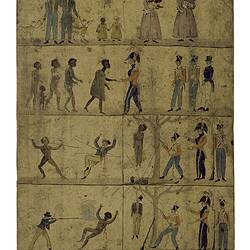Summary
Lithographic reproductions were issued by the Tasmanian Surveyor General's Office firstly in 1866 and again in 1867 of the Proclamation Boards, which were ordered by Governor George Arthur of Van Diemen's Land to be fastened to trees in areas where Aboriginal people would most likely see them following the declaration of martial law in 1828. The series of images on the boards and the lithographs are in colour and created a narrative of colonial inter-racial harmony. Of the original proclamation boards, Museums Victoria holds one of seven known to have survived. It is one of the most significant as it was part of the collection of the Aboriginal Protector, George Augustus Robinson. The boards were done as a precursor to the military action in that same year called the 'Black Line' when all Aboriginal people across Tasmania were rounded up.
The lithographs however were made as souvenirs for the 1866 Intercolonial Exhibition in Melbourne and the Paris Universal Exhibition the following year. While they were painted by hand, and perhaps from memory, each is individual and unique. In one register it depicts the story of an Aboriginal man spearing a European man with the murderer's subsequent hanging; and then the next register has a European man shooting an Aboriginal man with a rifle and that murderer's subsequent hanging. Text was added to the lithographs providing another layer of historical context to the history of the works, and varies to an extent across the editions that were produced in the 1860s. While Governor George Arthur instigated the original proclamation boards aimed at conciliation with Aboriginal people and an avoidance of violence, the text on the lithographs contains an important error noting that it was 'Governor Davey' who made the 'Proclamation to the Aborigines 1816'. The text printed at the bottom appears to be using a form of Creole or maybe Aboriginal English, and reads, 'Why - Massa Gubernor' - said Black Jack - 'You Proflamation all gammon - how / blackfellow read him? - eh! He no learn him book.' 'Read that then,' said the Governor, pointing to a picture.'
The continuation of the production of the imagery from the proclamation boards in the context of these international exhibitions is of particular historical importance, as it was at a time when there was much discontent with the question of slavery. A civil rebellion was underway in other British colonies, like the Jamaican Rebellion of 1865, and so the lithographs served to reinforce the so-called successes in this part of the British Empire with colonisation and the imposition of the rule of British law. The imagery is descriptive of a co-operative model or strategy of containment that is shadowed by a different reality.
The lithograph was originally received framed and mounted. The label on reverse of the frame revealed that the framing was done by John Pill at 152 Liverpool Street, Hobart. He worked from that address from 1896 to 1897. Further research relating to this may provide more information on the work. The work was removed and stabilised by Conservation Staff following purchase at auction.
Physical Description
Print on paper, handcoloured with watercolour, unframed and unmounted. The work has four horizontal registers of imagery, the upper two registers depict single events and the lower two capture two consecutive events. Black text printed at top and bottom with inscriptions. Inscription text: top, 'GOVERNOR DAVEY'S/ PROCLAMATION/ TO THE ABORIGINES/ 1816'; and bottom, 'Why - Massa Gubernor' - said Black Jack - 'You Proflamation all gammon - how / blackfellow read him? - eh! He no learn him read book. Read that then,' said the Governor, pointing to a picture.'
Significance
The lithograph is an original handpainted work of great significance historically. It is a reproduction of 'proclamation boards' produced in Van Dieman's Land and is a rare example of the derivative lithographs exhibited in nineteenth-century intercolonial and international exhibitions illuminating the use of the boards for imperial propaganda at various times. This lithograph was produced as a souvenir for the 1866 Intercolonial Exhibition in Melbourne. Of particular note in the text at the bottom is the reference to an iconic yet largely forgotten Aboriginal resistance fighter, 'Black Jack'. Black Jack was hanged in 1825 along with his more renowned counterpart in this action, 'Mosquito', and the imagery in the lithograph here shows an Aboriginal man being hanged.
More Information
-
Object/Medium
Lithograph
-
Maker
-
Locality
-
Date Produced
-
Number of Sheets
1
-
Number of Pages
1
-
Maximum dimensions
449 mm (Length), 264 mm (Width)
Measurement From Conservation. External measurement of lithograph
-
Framer
John Pill, 152 Liverpool Street, Hobart, Tasmania, Australia, 1896 - 1897
The lithograph was originally received framed and mounted. The label on reverse of the frame revealed that the framing was done by John Pill at 152 Liverpool Street, Hobart. He worked from that address from 1896 to 1897 -
Person Named
-
Person Named
-
Keywords
-
Type of item
-
Discipline
-
Category
-
Collecting Areas
Ethnohistory, Australian Indigenous - South-eastern Australia
Title
Governor Davey's Proclamation to the Aborigines, 1816

